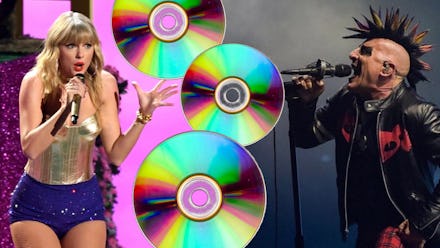Taylor Swift and Tool are keeping CDs alive in the streaming age

Musicians and labels are realizing there’s still money to be made from physical album sales, which is surprising considering 80 percent of industry revenue came from streaming in the first half of 2019. Nevertheless, two of the most visible case studies for the enduring relevance of CDs are recent releases by Taylor Swift and the rock band Tool.
Swift’s seventh album Lover debuted at number one on the Billboard chart and sold the equivalent of 867,000 copies its first week, according to Nielsen. 375,000 of those sales, or 43 percent, were physical CDs.
Swift sold four collector’s editions of the album exclusively through Target and negotiated a partnership with Amazon to move even more physical copies. She also shared pictures of fans who’d bought IRL copies of Lover on social media, shining her star power on those dedicated enough to invest in her.
“The fact that anyone can sell CDs to the younger age segment is a testament to their fanship,” Russ Crupnick, managing partner of MusicWatch, a market insights firm, told the New York Times. According to their research, only 15 percent of 13-to-24-year-olds listen to CDs. But a huge number of Swift’s fans are millennials and Gen-Xers, who might still have a soft spot for the passé medium.
The total number of physical albums sold in the US stayed nearly the same from last year to this one, growing from 27.7 million to 27.9 million, just 0.8 percent. However, total revenue increased by 5%, from $461 million to $485 million. This means consumers are willing to spend more to own an IRL copy of their music than they may have been a year ago, and retailers are taking note.
The band Tool released Fear Inoculum on August 30, selling a deluxe CD version of the album with elaborate packaging for nearly $45. Fans bought 87,000 copies at stores in the first week, and retailers hiked their prices to $65; by September 10, the 100,000 CDs distributed by RCA/Sony Music seemed completely sold out. The CDs were fetching between $155 and $205 apiece on the secondary market.
"We were overwhelmed by how fierce the fan reaction was," RCA co-president John Fleckenstein told Billboard. The collector’s edition CD of Fear Inoculum was meant to be a limited edition, but the label is working on manufacturing and shipping another release.
The trend in physical music ownership seems to be towards quality over quantity, industry players say. "Last summer, we felt we were beating our heads against the wall trying to get labels to put out more physical," Alliance Entertainment senior VP purchasing Laura Provenzano said. She told Billboard that labels responded with more vinyl and elaborate CD packaging. "Instead of a race to the bottom to see how many CDs we can sell at $7.99, now we can see how we can get $20 an album from consumers," Larry Mansdorf, senior buyer for 27-store franchise Newbury Comics, added.
Shifting purchase patterns could indicate audiences are thinking about their music consumption in a brand new way. Streaming makes it quick and easy to discover music and play anything in the world with a few taps. But investing in a physical copy of an album is a way to establish ownership of your favorite music, in an era when streaming collections can disappear with the crash of a server.